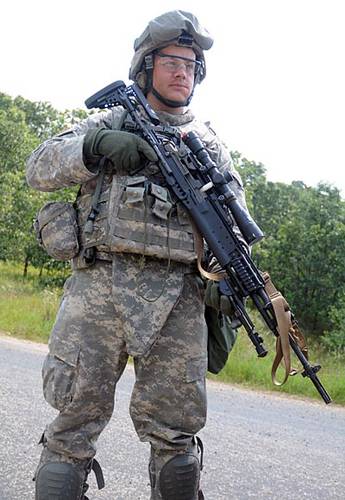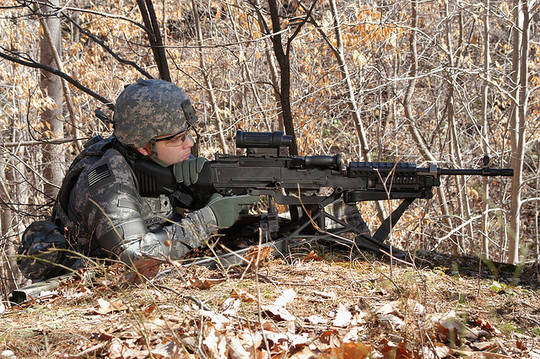[ This is the second guest post on US Infantry weapons written by Charles222, a 11-B/light infantryman in the United States Army. ]
This article will attempt to explain the nature of how the US Army Infantry Platoon fights, both on it’s own and as part of a company. It will describe the basic infantry precepts of the base of fire element and the maneuver element, and describe the use of supporting arms.
Firstly, the basic unit of maneuver is the fire team. It consists of four men: a rifleman, a team leader, a grenadier, and an automatic rifleman.
The rifleman is the utility infielder of the fire team. Armed with the lightest, handiest weapon and accompanying ammunition load, he frequently has other tasks on the battlefield, such as Combat Lifesaver, Sensitive Site Exploitation, or general load-bearer for additional items such as binoculars, additional ammo for the team, mortar rounds, etc. His role in the fight is of rapid, aimed fire against enemy targets. He may either be equipped with a regular M4 (possibly with an ACOG is there is one available, more usually with an M68 or an Eotech Holographic Weapons sigh) or for situations in which longer range is required (providing that he’s actually a good shot-riflemen are typically the most junior soldier in the team and so it is rare that he’s the best marksman) a specialized M16 variant or an M14 EBR.
The team leader is the leader of the team. Almost always a Specialist or Sergeant, E-5, his default weapon is also an M4, typically with an ACOG. In some units he also has the grenade launcher. I-and many other light infantry NCOs-feel that a M203 or M320 is an inappropriate weapon for the team leader, who by doctrine is supposed to direct firepower from the subordinate members of his team, as well as maneuver them when appropriate, not to employ firepower from his own personal weapon.
The grenadier is typically next most junior after the rifleman, although this isn’t always the case. He is armed with an M4 with a mounted M203 or M320, and ideally should have an Eotech, as ACOGs and M68s block out the launcher’s leaf sights. He typically has no other job, as the grenadier is typically carrying between 12 and 48 40mmm rounds of varying kinds (HE, HEDP, Smoke, Parachute Flare, and Star Cluster are the most common). His job in the fight is indirect fire out to approximately 350m for area targets, and 150m for point targets. His weapon has a kill radius of approximately 5 meters.
The automatic rifleman has the team’s most casualty-producing weapon, the M249 Squad Automatic Weapon. While is it belt-fed like it’s design cousin, the M240B Medium Machine Gun, that is where the similarities more or less end. The SAW is employed radically differently from the M240; while the platoon’s M240s are the centerpieces of their own gun teams, the M249 is an individual weapon and is treated as such; it is not the centerpiece of the fire team, but rather, another portion of it designed to provide volume firepower out to 600m against point targets, and area targets out to 800m. Typically automatic riflemen carry between 600 and 1000 rounds; if spare barrels are carried, it is typically only one, a long barrel to complement the standard short barrel.

Two fire teams make up a squad, with a squad leader; his job is not to employ or direct firepower, but to maneuver his teams using the terrain to their advantage. The squad may or may not have it’s own 3-man M240B team directly attached to it as well.
The platoon consists of three maneuver squads, one weapons squad with two 3-man M240B teams and a squad leader, a Radio Telephone Operator, a medic, two Forward Observers, a platoon leader, and a platoon sergeant. Infantry platoons may also gain additional attachments in the form of combat engineers, EOD technicians, dog handlers, etc. based on mission; the largest my platoon ever was was 59 Soldiers with attachments.
The platoon leader maneuver the squads against the enemy; the platoon sergeant handles the supporting elements (mortars, M240Bs,etc) as well as the casualty collection point.
The most basic battle drill, which all other battle drills draw from, is squad attack/react to contact. In this, one team acts as the base of fire, typically the front-most team, to fix the enemy in position and deny them the ability to maneuver. The other team flanks the enemy left or right based on which direction offers the most cover and concealment. This scales up to a platoon-sized react to contact, with one or more squads plus machine gun teams acting as the base of fire and the third squad acting as the flanking element. This basic bounding philosophy can be observed in all US Army Infantry battle drills; a platoon attack through a city features one squad occupying a building and setting up a base of fire for the next squad, which repeats until the objective is cleared.
Now that you’ve gotten a fairly in-depth description of who does what in an infantry platoon, I’ll attempt to illustrate how the different weapon systems all act together, and illustrate the use of snipers and other supporting arms.
The riflemen, with M4s , along with typically most of the fire team, handle the 0-300 meter zone. Grenadiers and Designated Marksmen can reach further, from approximately 65 meters for grenade launchers out to 350 meters for an area target; Designated Marksman can, depending on the rifle type, reach out to targets 500m away; it can be argued that the M16 offers a more useful weapon for this type of soldier, as it is significantly lighter and also inherently more accurate than the M14.
The M240 teams offer the most long-range firepower of any weapon type inherent in the infantry platoon. On a bipod, they are capable of hitting point targets 600m away, and area targets 800 meters away; when attached to a tripod, this lengthens to 800m for point targets and 1100 meters for area. A light infantry platoon has two such guns; Ranger platoons have 3 Mk.48s, which is feasible due to considerably lighter weapon weight compared to an M240, although they utilized the 3-team pattern when they still issued the M240B.
So, so far, we have pretty comprehensive firepower; riflemen and team/squad leaders can accurately engage to 300m, grenadiers to 350, and long-barrel equipped SAWs/DMs with M16s can reach to 5-600m. The M240 crews can reach to a full kilometer; if you’re engaging targets beyond that, you are or at least should be utilizing heavier weapons, which I’ll cover now.
The first exceptionally long-ranged weapon immediately available to an Infantry company is the M224 60mm mortar. In tripod, indirect-fire mode, this has a minimum range of 70m and a maximum range of 3,490 meters; in handheld fire, this changes to a minimum range of 75m and a maximum range of 1,340 meters. There are two of these in an Infantry company and typically, every soldier in the company can man-pack 2 rounds indefinitely, as my company did on every single mission in Afghanistan, for a total of approximately 100 rounds per gun. If the mortars are directly assigned to a platoon, this effectively extends the platoon’s maximum range to nearly 4 kilometers if necessary, at a rate of 20 rounds a minute until you run out of ammo. Mortars are frequently used in the direct-fire mode; while this cuts their range, it also makes them potent, quick to employ weapons with a range of nearly two kilometers, and also cuts system weight; the M224 system weighs 46 pounds with the tripod and baseplate, but only eighteen in direct-fire mode. The mortars can also be set up to block an enemy’s retreat from an attack with designated Known Firing Points, which the mortars can be pre-dialed in on to drop rounds on an enemy almost immediately.
Stryker infantry companies, which now form one-third of the US Army’s light and medium forces, also have an integrated sniper team. This team has an M203 grenade launcher, a Barrett M107 .50-cal LRSR, and an M2010/M24 sniper rifle. The .50 is accurate to approximately 1800 meters (for their shots, such as a Canadian sniper’s world-record 2,700-meter shot in Afghanistan, are possible, but the official, no-BS range is 1800m); the M24/M2010 is accurate to approximately 1,000m for the M24 and 1,500m for the M2010. Sniper teams are typically used either in support of an attack, by locking down lanes of potential retreat, or as observation posts, to watch for enemy movement either in or out of the objective. They can be used in conjunction with mortar teams, the snipers calling for fire as they observe enemy movement-this allows them to kill the enemy without revealed their positions by firing.
There are of course other weapon systems-fixed-wing aircraft, helicopters, armed UAVs, and howitzers-available for the fire-support mission, but I’ll save those for another time; they’re not typically utilized except when absolutely needed.
 Your Privacy Choices
Your Privacy Choices





